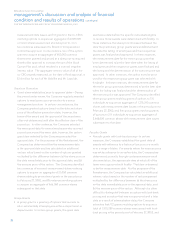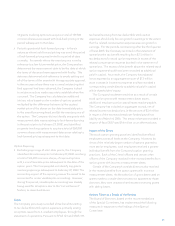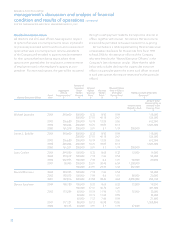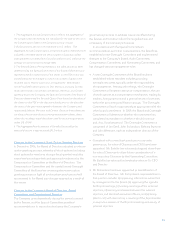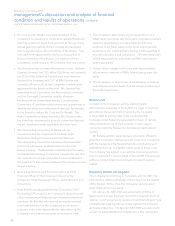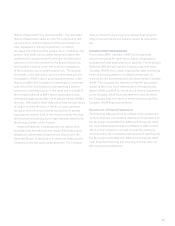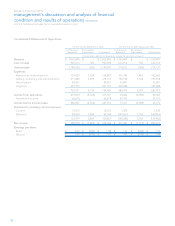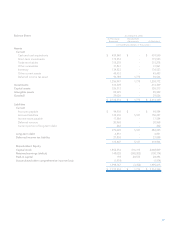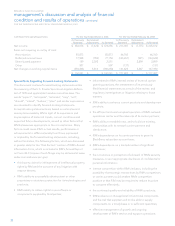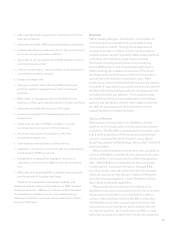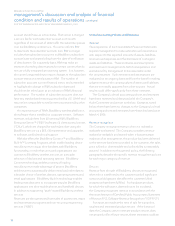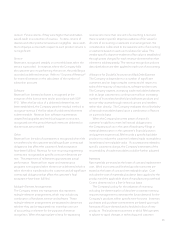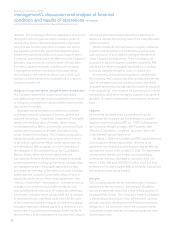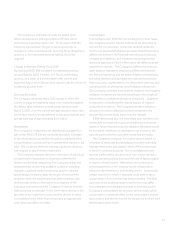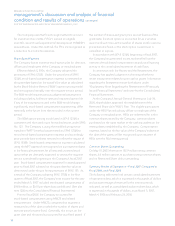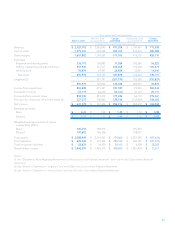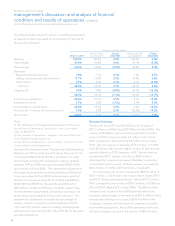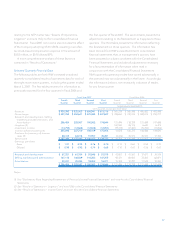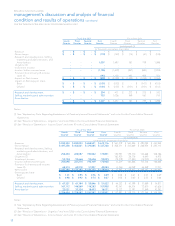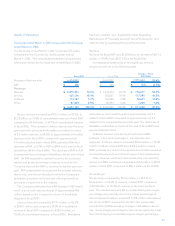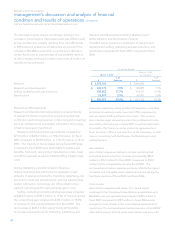Blackberry 2007 Annual Report Download - page 32
Download and view the complete annual report
Please find page 32 of the 2007 Blackberry annual report below. You can navigate through the pages in the report by either clicking on the pages listed below, or by using the keyword search tool below to find specific information within the annual report.30
RESEARCH IN MOTION LIMITED
management’s discussion and analysis of financial
condition and results of operations continued
FOR THE THREE MONTHS AND FISCAL YEAR ENDED MARCH 3, 2007
account should have an active status. That carrier is charged
a service fee for each subscriber account each month
regardless of the amount of data traffic the subscriber passes
over the BlackBerry architecture. If a carrier informs RIM
to deactivate the subscriber account, then RIM no longer
includes that subscriber account in its BlackBerry subscriber
account base and ceases billing from the date of notification
of deactivation. On a quarterly basis, RIM may make an
estimate of pending deactivations for certain carriers that do
not use a fully-integrated provisioning system. It is, however,
the carrier’s responsibility to report changes to the subscriber
account status on a timely basis to RIM. The number of
subscriber accounts is a non-financial metric and is intended
to highlight the change in RIM’s subscriber base and
should not be relied upon as an indicator of RIM’s financial
performance. The number of subscriber accounts does not
have any standardized meaning prescribed by U.S. GAAP and
may not be comparable to similar metrics presented by other
companies.
An important part of RIM’s BlackBerry wireless platform is
the software that is installed on corporate servers. Software
revenues include fees from (i) licensing RIM’s BlackBerry
Enterprise Server™ (“BES”) software; (ii) client access licenses
(“CALs”), which are charged for each subscriber using the
BlackBerry service via a BES; (iii) maintenance and upgrades
to software; and (iv) technical support.
RIM also offers the BlackBerry Connect™ and BlackBerry
Built-In™ Licensing Programs, which enable leading device
manufacturers to equip their handsets with BlackBerry
functionality, in order that users and organizations can
connect to BlackBerry wireless services on a broader
selection of devices and operating systems. BlackBerry
Connect technology enables a variety of leading
manufacturers to take advantage of proven BlackBerry
architecture to automatically deliver email and other data to
a broader choice of wireless devices, operating systems and
email applications. BlackBerry Built-In technology enables
leading manufacturers to incorporate popular BlackBerry
applications into their mobile phones and handheld devices
in addition to supporting “push”-based BlackBerry wireless
services.
Revenues are also generated from sales of accessories, repair
and maintenance programs and non-recurring engineering
services (“NRE”).
Critical Accounting Policies and Estimates
General
The preparation of the Consolidated Financial Statements
requires management to make estimates and assumptions
with respect to the reported amounts of assets, liabilities,
revenues and expenses and the disclosure of contingent
assets and liabilities. These estimates and assumptions
are based upon management’s historical experience and
are believed by management to be reasonable under
the circumstances. Such estimates and assumptions are
evaluated on an ongoing basis and form the basis for making
judgments about the carrying values of assets and liabilities
that are not readily apparent from other sources. Actual
results could differ significantly from these estimates.
The Company’s critical accounting policies and estimates
have been reviewed and discussed with the Company’s
Audit Committee and are set out below. Except as noted
below, there have been no changes to the Company’s critical
accounting policies and estimates from those disclosed as at
March 4, 2006.
Revenue recognition
The Company recognizes revenue when it is realized or
realizable and earned. The Company considers revenue
realized or realizable and earned when it has persuasive
evidence of an arrangement, the product has been delivered
or the services have been provided to the customer, the sales
price is fixed or determinable and collectibility is reasonably
assured. In addition to this general policy, the following
paragraphs describe the specific revenue recognition policies
for each major category of revenue.
Devices
Revenue from the sale of BlackBerry devices is recognized
when title is transferred to the customer and all significant
contractual obligations that affect the customer’s final
acceptance have been fulfilled. For hardware products
for which the software is deemed not to be incidental,
the Company recognizes revenue in accordance with the
American Institute of Certified Public Accountants Statement
of Position 97-2, Software Revenue Recognition (“SOP 97-2”).
Provisions are made at the time of sale for warranties,
royalties and estimated product returns. If the historical
data the Company uses to estimate product returns does
not properly reflect future returns, these estimates could be


